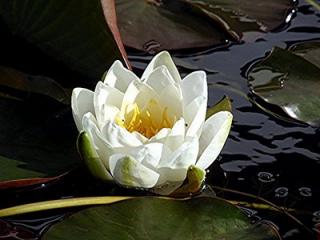White Lotus Seed, Potential Food but Uncultivated Yet

Lotus or called the water lily is a quite popular aquatic plant growing wildly in lakes or swamps. This plant, which flowers throughout the year, is included in the family of Nymphaceae. The flowers appear on the surface of water, blossoming at 18:00 to 19:00 and closing the next day before noon. The flower produces a round fruit of 4-12 centimeters in diameter. The flower seeds are blackish brown, stored in its fruit and have a hard outer skin.
An on-field study on the island of Kalimantan by a lecturer of the Department of Community Nutrition, Faculty of Human Ecology, Bogor Agricultural University (FEMA-IPB), Prof.Dr.Ir.Ahmad Sulaeman, MS shows that lotus seeds or commonly called ghol have good production potential, although they have not been cultivated. "They are not much utilized by the local communities except for use as ingredients mixed with rice," says Prof. Ahmad. Together with other colleagues in the Department (Dr. Ir. Sri Anna Marliyati, Prof.Dr.Ir. Ali Khomsan, and Dr.Ir.Lilik Kustiyah), Prof. Ahmad studied the physical, chemical, and functional characteristics of white lotus seed (Nymphaea alba), its flour and usage as a potential food stuff.
Physically, the seed of white lotus has a small round shape with a blackish green color like mung beans before milling. It becomes brown after milling. The surface of milled grains is even and smooth, sandy-textured with a weight per hundred grains of about 0.14 grams. These seeds can also be processed into flour with these characteristics: kamba density of 0.29 grams per milliliter, whiteness of 48, acidity (pH) of 6.23, viscosity of 3.7 centiPoise (cP) and dough expansion capacity of 37 %. The ghol flour is potential for use as substitute for wheat flour. "Besides, the yield of milled ghol and that of ghol flour are quite high, i.e. respectively 78% and 88%, "explained Prof. Ahmad.
Further, Prof. Ahmad describes that the white lotus seeds have high nutritional content, especially starch, fats and proteins. In fact the protein content is greater than that of cereal flour. Lotus seed flour also contains amino acids and complete essential acids. This opens up the opportunity as an alternative food besides the cereals so far consumed as staple food and tubers.
In terms of physical properties, ghol flour can also be used as an ingredient as a substitute for wheat flour in making cakes and bread to a certain extent. "The higher proportion of substitution turned out to increase the nutrient contents of products namely water content, protein and fat," said Prof. Ahmad. The results of sensory test of the substituted products, which include color, flavor, texture, and taste, show that these products are accepted by the panelists up to 60 % for cakes and 30 % for bread. It means that ghol flour can replace wheat flour in making cakes and bread up to 60 % and 30 % respectively.
Based on the nutrient composition and acceptability, the best cake is one that is made from wheat flour substituted by ghol flour up to 50 %. However, bread products do not appear to show significant difference; up to 30 % of ghol four it still produces good quality bread, except in terms of color. According to Prof. Ahmad, a further research is needed on the post-harvest technology to obtain whiter flour.
Another advantage is the seeds with Latin name Nymphaea pubescens Willd are also useful as the drug, an alternative antibiotics for diarrhea. In another study, some researchers of IPB Prof. Made Astawan, Prof. Suwarno S. Soekarto, Dr.Komang Wiryawan and Dr.Tutik Wresdiyati have examined the antibacterial property of lotus seed extract. Lotus seed extract has antibacterial capacity against Salmonella typhimurium (causing typhoid) and Enteropathogenic Escherichia coli (EPEC). Their study shows that lotus seed extract contains a phytochemical components, glycosides, terpenoids (steroids and saponins), flavonoids, triterpenoids, tannins and alkoloid. (mtd)


